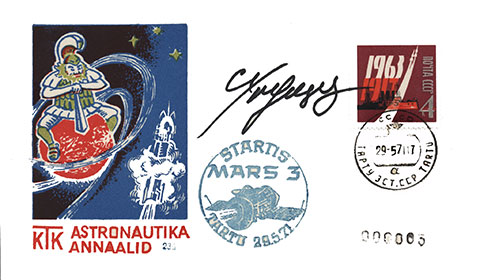Mars 3 was one of the many space objects launched aboard the powerful Proton rocket, signed by Sergei Khrushchev who led the Proton program.Space Cover #420: Proton rocket launch to Mars
The Proton Rocket was a workhorse rocket of the USSR. Its designer was Sergei Khrushchev, the son of Nikita Khrushchev, who had served as First Secretary of the Communist Party of the Soviet Union from 1953 to 1964 and as Chairman of the Council of Ministers, or Premier, from 1958 to 1964. Nikita Khrushchev was responsible for the de-Stalinization of the Soviet Union, for backing the progress of the early Soviet space program, and for several relatively liberal reforms in areas of domestic policy. Khrushchev's party colleagues removed him from power in 1964.
Prior to emigrating from the Soviet Union to the United States in 1991, Dr. Khrushchev worked in various high-level engineering positions. From 1968 to 1991, he served at the Control Computer Institute in Moscow, where he rose from section head to first deputy director in charge of research. From the years 1958 to 1968, Dr. Khrushchev worked as an engineer, then later as a deputy section head in charge of guidance systems for missile and space design.
In this capacity, he worked on cruise missiles for submarine craft, military and research spacecraft moon vehicles and the "Proton" space booster rocket. He was deeply involved in the development of this rocket which has had a wide array of uses in the Soviet and the current programs where it is currently used to ferry supplies to the International Space Station.
Proton rockets also flew several early missions to Mars.
This May 29, 1971 cover, canceled in Tartu, USSR was created for the launch of the Mars 3 mission, launched on a Proton Rocket and signed by Sergei Khrushchev.
Although Les Winick was told by the Kniga Agency that Tartu covers were illegal, the subject of illegality is subject to interpretation.
Creating cacheted covers for space events was considered a "capitalistic" endeavor by the Soviet government, which made the creation of such covers, "illegal." However, the cancel was applied at the post office in Tartu and that was not counterfeited. In the U.S. cover dealers routinely made cachets and had the post offices cancel them on appropriate dates. That is why I collected them even when they were said to be illegal, and why I have a cover signed by the head developer of the Proton rocket.












